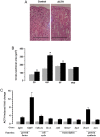Transcription controls growth, cell kinetics and cholesterol supply to sustain ACTH responses
- PMID: 28720595
- PMCID: PMC5574282
- DOI: 10.1530/EC-17-0092
Transcription controls growth, cell kinetics and cholesterol supply to sustain ACTH responses
Abstract
Chronic ACTH exposure is associated with adrenal hypertrophy and steroidogenesis. The underlying molecular processes in mice have been analysed by microarray, histological and immunohistochemical techniques. Synacthen infused for 2 weeks markedly increased adrenal mass and plasma corticosterone levels. Microarray analysis found greater than 2-fold changes in expression of 928 genes (P < 0.001; 397 up, 531 down). These clustered in pathways involved in signalling, sterol/lipid metabolism, cell proliferation/hypertrophy and apoptosis. Signalling genes included some implicated in adrenal adenomas but also upregulated genes associated with cyclic AMP and downregulated genes associated with aldosterone synthesis. Sterol metabolism genes were those promoting cholesterol supply (Scarb1, Sqle, Apoa1) and disposal (Cyp27a1, Cyp7b1). Oil red O staining showed lipid depletion consistent with reduced expression of genes involved in lipid synthesis. Genes involved in steroidogenesis (Star, Cyp11a1, Cyp11b1) were modestly affected (P < 0.05; <1.3-fold). Increased Ki67, Ccna2, Ccnb2 and Tk1 expression complemented immunohistochemical evidence of a 3-fold change in cell proliferation. Growth arrest genes, Cdkn1a and Cdkn1c, which are known to be active in hypertrophied cells, were increased >4-fold and cross-sectional area of fasciculata cells was 2-fold greater. In contrast, genes associated with apoptosis (eg Casp12, Clu,) were downregulated and apoptotic cells (Tunel staining) were fewer (P < 0.001) and more widely distributed throughout the cortex. In summary, long-term steroidogenesis with ACTH excess is sustained by genes controlling cholesterol supply and adrenal mass. ACTH effects on adrenal morphology and genes controlling cell hypertrophy, proliferation and apoptosis suggest the involvement of different cell types and separate molecular pathways.
Keywords: ACTH; adrenal hyperplasia; adrenal hypertrophy; cholesterol.
© 2017 The authors.
Figures






Similar articles
-
Corticosterone regulates cell proliferation and cytochrome P450 cholesterol side-chain cleavage enzyme messenger ribonucleic acid expression in primary cultures of fetal rat adrenals.Endocrinology. 1994 Nov;135(5):2064-9. doi: 10.1210/endo.135.5.7956928. Endocrinology. 1994. PMID: 7956928
-
Chronic stress induces adrenal hyperplasia and hypertrophy in a subregion-specific manner.Am J Physiol Endocrinol Metab. 2006 Nov;291(5):E965-73. doi: 10.1152/ajpendo.00070.2006. Epub 2006 Jun 13. Am J Physiol Endocrinol Metab. 2006. PMID: 16772325
-
The acute and chronic effects of adrenocorticotropin on the levels of messenger ribonucleic acid and protein of steroidogenic enzymes in rat adrenal in vivo.Endocrinology. 1998 Sep;139(9):3913-22. doi: 10.1210/endo.139.9.6196. Endocrinology. 1998. PMID: 9724047
-
Lipoprotein utilization and cholesterol synthesis by the human fetal adrenal gland.Endocr Rev. 1981 Summer;2(3):306-26. doi: 10.1210/edrv-2-3-306. Endocr Rev. 1981. PMID: 6268397 Review.
-
Effects of Chronic ACTH Excess on Human Adrenal Cortex.Front Endocrinol (Lausanne). 2017 Mar 8;8:43. doi: 10.3389/fendo.2017.00043. eCollection 2017. Front Endocrinol (Lausanne). 2017. PMID: 28337175 Free PMC article. Review.
Cited by
-
Asymmetries of Left and Right Adrenal Glands in Neural Innervation and Glucocorticoids Production.Int J Mol Sci. 2023 Dec 14;24(24):17456. doi: 10.3390/ijms242417456. Int J Mol Sci. 2023. PMID: 38139285 Free PMC article.
-
11β-Hydroxysteroid Dehydrogenases and Hypertension in the Metabolic Syndrome.Curr Hypertens Rep. 2017 Nov 14;19(12):100. doi: 10.1007/s11906-017-0797-z. Curr Hypertens Rep. 2017. PMID: 29138984 Free PMC article. Review.
-
The transcription factor HHEX maintains glucocorticoid levels and protects adrenals from androgen-induced lipid depletion.Res Sq [Preprint]. 2025 Apr 15:rs.3.rs-6248794. doi: 10.21203/rs.3.rs-6248794/v1. Res Sq. 2025. PMID: 40321776 Free PMC article. Preprint.
-
Renal and Blood Pressure Response to a High-Salt Diet in Mice With Reduced Global Expression of the Glucocorticoid Receptor.Front Physiol. 2018 Jul 9;9:848. doi: 10.3389/fphys.2018.00848. eCollection 2018. Front Physiol. 2018. PMID: 30038578 Free PMC article.
-
DHCR24, a Key Enzyme of Cholesterol Synthesis, Serves as a Marker Gene of the Mouse Adrenal Gland Inner Cortex.Int J Mol Sci. 2023 Jan 4;24(2):933. doi: 10.3390/ijms24020933. Int J Mol Sci. 2023. PMID: 36674444 Free PMC article.
References
-
- Artemenko IP, Zhao D, Hales DB, Hales KH, Jefcoate CR. Mitochondrial processing of newly synthesized steroidogenic acute regulatory protein (StAR), but not total StAR, mediates cholesterol transfer to cytochrome P450 side chain cleavage enzyme in adrenal cells. Journal of Biological Chemistry 2001. 276 46583–46596. (10.1074/jbc.M107815200) - DOI - PubMed
Grants and funding
LinkOut - more resources
Full Text Sources
Other Literature Sources
Molecular Biology Databases
Research Materials
Miscellaneous

